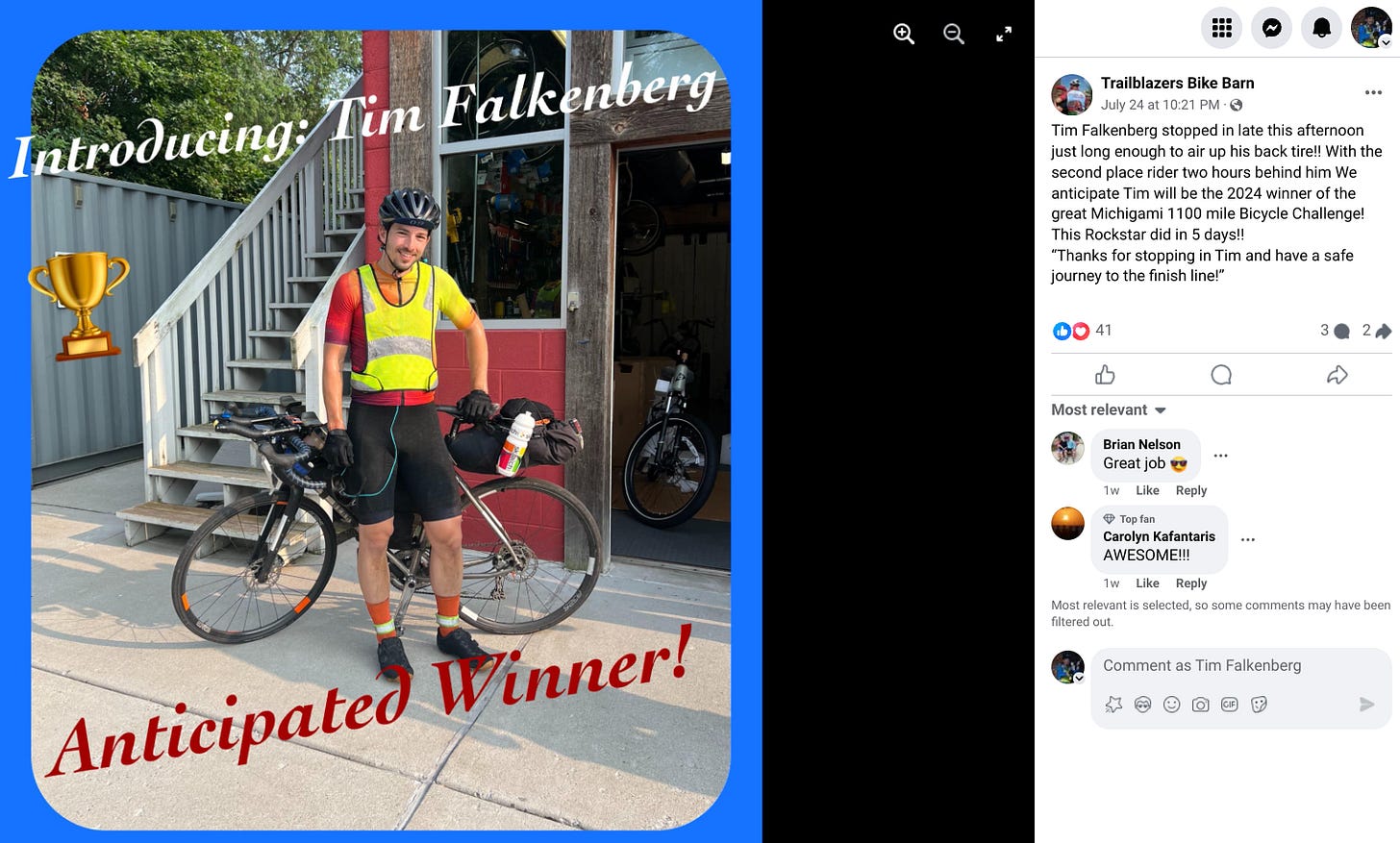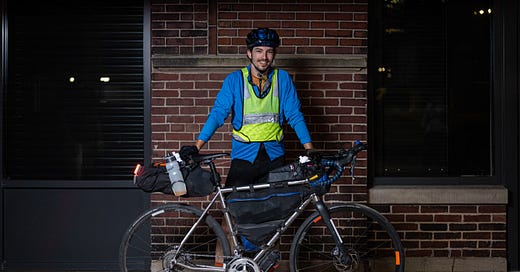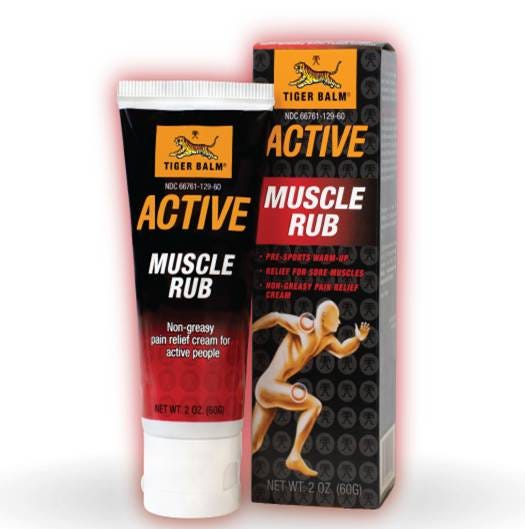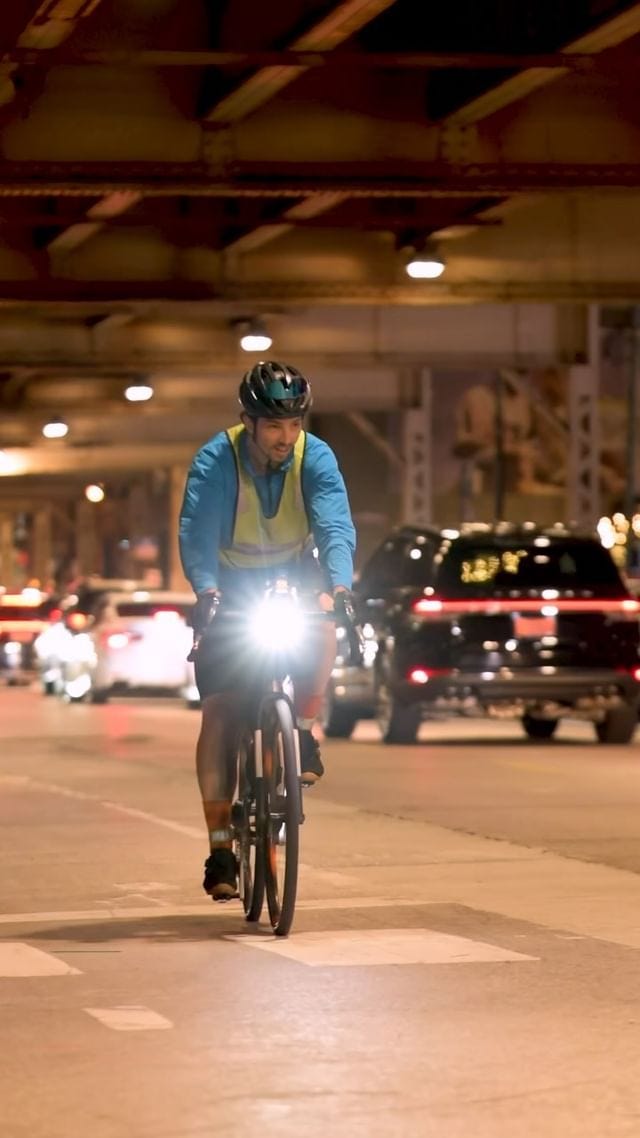Day 5 - 2024 Mishigami Challenge
The final day, the final miles, the final struggle towards achieving an FKT.
The Mishigami Challenge is an 1100+ mile (nearly 1800km) race on a set route around Lake Michigan. I competed in the first edition of the race in 2022, coming in second, and won the 2024 race while setting a course FKT.
Over the next several days, I’ll be publishing my day-by-day account of the 2024 race. I’ve also linked my GPS file at the bottom of each recap.
You can find more about the Mishigami Challenge on their website, Instagram, and Facebook pages. You - yes you! - should think about signing up for the 2025 edition of the challenge. It really is a special event!
Missed a day’s recap? Find them here:
Day 5
The last day of the 2024 Mishigami Challenge was hard.
In my ambitious pre-race planning, I’d hoped to make the last day less than 200 miles - still a long day, but comparatively short. Instead, I had over 220, most of that extra distance still carried over from day 2.
A brief aside about planning for bikepacking and ultradistance races. These races absolutely demand that you plan and account for as many details as possible. You’re also basically guaranteed not to stay on plan. There are too many little things that can happen. It’s why my cheat sheet had not just the four places I hoped to spend my nights, but over a dozen other options in case I had to stop short or (ambitiously) went long. There’s a part of me that imagines I would have stayed on my original schedule if I hadn’t had mechanicals, even if it had meant riding later into the night a couple times. For example: on day 2, I lost a couple hours to my mechanical issues, but getting to the camp I originally planned for would have taken close to three additional hours of riding. It was an ambitious plan. Maybe I would have stuck to it out of the necessity to make it to the next available campsite. Maybe not. But the reality is that things happen in ultradistance, and you have to adapt. Rarely do you get to run a perfect race over these distances. Just ask my competitors, who also dealt with mechanicals, missing gear, the elements, and more.
As it was, the last day of the race for me was a 368km (228mi) “sprint” from the north side of Muskegon on three hours sleep, because Sarah Rice was charging hard and I was not going to be caught by sleeping too much on the final night. (I found out after the race that Sarah only slept about 90 minutes before beginning her 300+ mile charge to the finish. Welcome to ultras.) I woke after a couple hours and checked Sarah’s progress on the race tracker, then got up an hour later and got rolling with just over a 20 mile gap. A Pepsi from the motel vending machine was breakfast, and a good thing, too, because at 4:30 local time, neither the one McDonald’s nor the one gas station on route through Muskegon was open yet.
I supplemented the Pepsi with the last energy bars I had, but that was all I got until reaching Holland, MI at 74km in, because nearly the full stretch from Muskegon to Holland is through very fancy residential neighborhoods with nothing commercial nearby. Pretty roads, but no resupply around.
That morning was also when I realized I had a problem with my neck. Those roads would have been perfect for getting in the aero bars and tapping out a hard cadence. But I couldn’t do it. Shermer’s Neck isn’t quite painful, but it certainly isn’t comfortable either. It feels like you’ve just totally lost connection with a part of your body, like at best it won’t do what you want it to and at worst it’s actively fighting you. Staying on the hoods, at least, was still comfortable at this point, so I grabbed coffees, honey buns, and more from a Holland gas station and kept moving quickly.
Now: I can look at my GPS file and know that it was right around 100 miles from Holland to New Buffalo. But I cannot remember this part of the course hardly at all. I know that I made some brief, intermediate stops for food and water. I know that I listened to podcasts and music much of the way, something I almost never do on the bike. I know that I had phone calls with my wife and mother-in-law, and that these were wonderful distractions.
I also know that I spent an increasing amount of time with my hands on the elbow pads of my aero bars so that I could sit very upright on my bike and protect my neck from strain as best I could. Many of these roads were good and the wind was manageable at worst. My legs even felt so good that I could push through the horribly un-aerodynamic position I was in to hold 26kph or better through several sections. But I could not really push the pace, and I felt constantly hampered by the increasing pain and soreness down my neck and between my shoulder blades.
At New Buffalo, I took a slightly longer stop to try to address my worsening neck problems and get ready for the final push to the finish line. I got a tube of pain relief cream and smeared about half of it on as much of my neck and shoulders as I could reach. I resupplied at a supermarket and sat for a few minutes in the shade eating chips and drinking a Coke. The cream and rest did seem to help - at least a little - so with Sarah still chasing me (I do also remember checking the race tracker at every stop and the gap remaining steady at anywhere from 20 to 30 miles) I got moving again.
It’s funny the tricks that pain, exhaustion, and memory will play on you. From New Buffalo to the finish is a section of the route I know fairly well. Of course, I rode it in 2022 (some minor 2024 changes aside, although I think these were mostly between Benton Harbor and New Buffalo), but closer in towards Chicago are portions I’ve ridden several other times. So it was that I passed much of this section in a half-haze. Yes, there were the beachfront communities around Michigan City. There were the dunes preserve roads that connected some of them. In Chesterton, I made my final resupply stop at the exact same gas station I had in 2022 (and made sure to buy enough that I wouldn’t bonk in the home stretch this time.) The bike paths that carry riders across most of Indiana played tricks on my head. Wasn’t this part of the path much closer to the end? No, it was wishful thinking then, and it’s wishful thinking again now. More phone calls from friends and family helped push me onwards, along with the growing knowledge that I wouldn’t be caught if I could just. Keep. Going.

Indiana felt interminable, in large part because I did remember each and every section of the bike path that carried me through, I just couldn’t place in my mind how they all linked together. As I crossed finally into Illinois, I was fighting my neck hard. I was riding upright with my hands on my aero bar elbow pads as much as I possibly could, going down to the hoods only for portions of the path that I either needed to brake or needed to exercise better bike control. I had been genuinely concerned for hours that if this got worse I might be forced to quit at the very end of this adventure. That worry didn’t abate the closer I got to the finish.
But I kept putting more cream on my neck and massaging myself as well as I could. This did repeatedly loosen my neck and shoulders a little, so it allowed me to go on safely. Just north of Wolf Lake, right before I came properly into Chicago, I used basically the last of my cream. (Yes, I went through an entire tube in under six hours.) I also started banging on my shoulder and neck with my fist in an attempt to loosen them up; the first such assault on each side yielded a satisfying, audible muscle crack and some immediate relief.
I kept thinking, “Just make it to the lakefront. Just get away from the traffic.” Normally from Wolf Lake this is a trivial thing for me - I’ve ridden to and from there many, many times. But normally I’m not fighting severe neck fatigue with over 1000 miles in my legs.
Eventually, though, I did make it. As it became dark, I pulled through the final sections of south side neighborhood and was able to merge onto the lakefront trail. I’ve never felt such relief over still being ten miles away from a finish line. Once again, and just like I had all day, I found myself lamenting my inability to push my pace. It was dark, but the city lights aided visibility. There were few people on the trail. It was pleasant out, and the meandering bike path can be so much fun to ride. But I couldn’t. I still had to manage my neck on a moment-to-moment basis. Five miles from the finish, I even pulled over and did a back bend over a park bench, trying to use the top of it like a makeshift foam roller.
I’d also been watching the clock.
At the start of the race, I had several time goals. This first was simply to finish in less than five days. Coming in on the evening of the fifth day meant I was easily under that mark, since we’d only hit five days of race time at 6am the next morning. The second was to finish 24 hours faster than I had in 2022. This was actually the first goal I set for myself, all the way back in late 2022 before the 2023 edition of the race was canceled. I didn’t quite achieve this goal, but I feel ok about it. As I said before, nobody’s race is ever perfect over these kinds of distances, and I do feel that I achieved this goal in spirit - with the effort I put in both in training and in the race itself - if not quite in fact.
The last goal I set was to finish the race in under 4 days, 12 hours. This would have put my finishing time more than 24 hours better than the previous fastest time. It’s also approaching the limit of what I consider “reasonably achievable” for this course. Here’s what I mean.
This year I started to approach the limit of how little sleep I could get without becoming a completely miserable zombie on the bike. However, I don’t think I quite hit the limit. So there are a few hours that one could potentially cut there. Without the mechanical missteps I made or the neck issues I had on the final day, there are also potentially a few hours to save by simply moving more quickly. However, as I’ve now said several times, no one runs a perfect race in ultradistance. You have to overcome the hurdles, whether it’s mechanicals, route diversions, weather, or anything else.
So: Somewhere in the neighborhood of 4 days, 10 hours to 4 days, 12 hours seems like an achievable time for the Mishigami course, even if it’s a big challenge to do it. I expect that at least aiming for this target is what it’s going to take to win in the future. On the flipside, going very much below this time is going to become exponentially more difficult with each hour, requiring riders to cut sleep aggressively, ride faster overall, and/or achieve a run/rest rate of 75% or better. (For context, I was at 67% run this year, with Sarah topping the field at 71% run.)
I finally did roll into the finish at 4 days, 14:59. (Or 4 days, 4:45 if you account for the start rolling out at 6:15, not 6am, but who’s counting?) I love that the course was modified to start and end in downtown Chicago this year. Coming in amongst the traffic and lights of a Chicago evening was harrowing in some ways, but I wouldn’t trade it. It added so much to the experience.
I was - I am - so filled with joy at having finished the Mishigami Challenge yet again, never mind having won it this year. Ok, I’m pretty excited to have won it, too, but this is a worthwhile adventure whether you finish at the front of the field or the back.
It was so much fun to have my wife waiting for me at the finish. She has been so supportive of my training for this event, even as it’s taken huge chunks of my time for months on end. She’s amazing.
It was also great to have race director Jack Peck and his media team there for photos and interviews for their forthcoming race documentary. Jack has done great work to build on Mike Nichols’ foundation and set this event up for many successful years to come.
I will be writing more soon about my gear, with an in-depth look at what I brought, what worked, and what I would change in the future, but for now I want to end on a note of joy.
Riding bikes is a joyful activity. It can be hard. It can be exhausting. But the bicycle is an instrument of joy. So whether it’s for one mile or 100, get outside. Ride a bike. Have a joyful adventure.









That was a fun read, Tim! I can't wait to give this challenge a shot this year!
Well written, Tim! Kudos again for a fantastic ride.